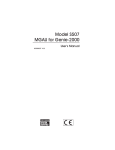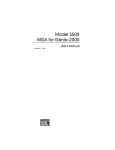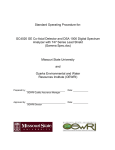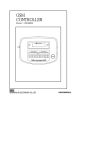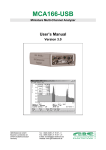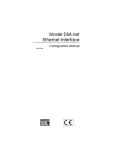Download Model S507 MGAU for Genie-2000
Transcript
Model S507 MGAU for Genie-2000 9230992B 6/99 User’s Manual Copyright 1999, Canberra Industries. All rights reserved. Canberra Industries, 800 Research Parkway, Meriden, CT 06450 Tel: 203-238-2351 FAX: 203-235-1347 http://www.canberra.com This manual contains proprietary information; no part of it may be reproduced or used in any form or by any means – graphic, electronic, or mechanical, including photocopying, recording, or information storage and retrieval systems – without the written permission of Canberra Industries. The information in this manual describes the product as accurately as possible, but is subject to change without notice. Printed in the United States of America. Table of Contents 1. Introduction. . . . . . . . . . . . . . . . . . . . . . . . . . . . . . . 1 2. Installation . . . . . . . . . . . . . . . . . . . . . . . . . . . . . . . 2 3. Operation . . . . . . . . . . . . . . . . . . . . . . . . . . . . . . . . 3 Restrictions . . . . . . . . . . . . . . . . . . . . . . . . . . . . . . . . . . . . . . . . . . . . . . . 3 Interactive Mode . . . . . . . . . . . . . . . . . . . . . . . . . . . . . . . . . . . . . . . . . . . . 4 4. MGAU Batch Commands . . . . . . . . . . . . . . . . . . . . . . . 7 A. MGAU Input Parameters. . . . . . . . . . . . . . . . . . . . . . . . 9 B. MGAU Output Parameters . . . . . . . . . . . . . . . . . . . . . . 11 C. MGAU Error Messages . . . . . . . . . . . . . . . . . . . . . . . . 13 D. Example MGAU Reports . . . . . . . . . . . . . . . . . . . . . . . 16 A Typical Standard Mode Report . . . . . . . . . . . . . . . . . . . . . . . . . . . . . . . . . . . 16 A Typical Enrichment Meter Analysis Report . . . . . . . . . . . . . . . . . . . . . . . . . . . . 17 1. Introduction This document describes how to install and operate the Multi-Group Analysis for Uranium (MGAU) application for the Genie-2000 environment. The MGAU application analyzes the Ge spectra of uranium samples, and reports the relative abundances of the uranium isotopes in the sample. The basic Gamma Acquisition and Analysis application requires a spectrum to be energy and efficiency calibrated before analysis, and sequentially calls several analysis algorithms to perform the analysis. MGAU only requires that the spectra be energy calibrated, and it performs its entire analysis in one step. Beginning with V2.1, MGAU is also capable of determining the 235U enrichment of a sample by the traditional “enrichment meter” method of analysis. Beginning with V2.1, the enrichment method was added because it continues to be the only practical, nondestructive method for analyzing uranium samples that are not in equilibrium with their daughter products, or that are contained in thick (highly absorbing) steel containers. However, the “enrichment meter method” does require that the detector system be calibrated before analyses can be performed on unknown samples. Furthermore, the method usually can be used only when measuring samples with several mean paths of sample thickness at the 186 keV gamma-ray energy (so called “infinitely thick” criteria). Version 2.1 is also capable of analyzing samples containing thorium. Such samples produce several additional peaks, including thorium x rays that directly interfere with the peaks that are analyzed in the 89-100 keV region. These versions also account for the daughter products’ interferences of 234U when analyzing samples containing uranium ore. 2. Installation To install MGAU on your computer, open an Windows 95/NT command window, insert the installation disk into a floppy drive, and type: a:\setup If you are using drive b:, type: b:\setup 2 3. Operation In the batch environment (see “MGAU Batch Commands” on page 7), the datasource(s) must be specified in the command to execute MGAU. In the Gamma Acquisition and Analysis application, the datasource is specified with the File | Open datasource… menu option. If the datasource(s) are uninitialized for MGAU parameters, the defaults (shown in Appendix A, MGAU Input Parameters) are assumed. Otherwise, the parameter values in the datasources are used. To ensure that the analysis algorithms work correctly when MGAU is analyzing the uranium spectrum, the 98 keV and 185 keV peaks (emitted by all uranium samples) must be present. If they are not found (they do not exceed the uncertainty threshold), the uranium spectrum cannot be analyzed. Consequently, the program issues an error message indicating that the marker peaks were not found. In batch mode and in the Interactive mode, run the general purpose report program to produce the desired report. Appendix C, MGAU Output Example, shows a typical MGAU report. The Report program’s standard syntax allows you to specify the report template file name and section, where to direct the report, and so on. Refer to the “Report Template Files” chapter in the Genie-2000 Customization Tools Manual for details. Restrictions The MGAU program for Windows 95/NT requires that the Model S500, Model S502 or Model S504 Genie-2000 Basic Spectroscopy software already be installed on your computer. MGAU is designed for a single detector mode only and is limited to 4K spectra. The single spectrum energy calibration gain setting must be within 0.005 keV/channel of the nominal 0.075 keV/channel. This version of MGAU supports only the CAM file format. Any other file formats must be converted to the CAM format with the FILECNVT batch command (refer to the Genie-2000 Customization Tools Manual, Chapter 3, Batch Procedure Reference). No graphic output of the fits to the screen is supported. Also, this version only supports analysis from saved spectrum files (analysis direct from the hardware is not supported). 3 Operation The MGAU application, which is available as a batch command or as an analysis algorithm, analyzes spectra containing only uranium. If plutonium is present, it returns an error code. Interactive Mode MGAU can be started from the Gamma Acquisition and Analysis application’s Analyze menu. To use MGAU from within this window: 1. Open a datasource. 2. Select the Analyze Menu from the Gamma Acquisition and Analysis’ menu bar to see the list of analysis phases. 3. Select MGAU from the MGA/MGAU menu item. You’ll see the setup screen shown in Figure 1. Figure 1 MGAU Analysis Setup Analysis Mode Choose the analysis mode by selecting one of the buttons in this group. Each mode is fully described elsewhere in this manual: 4 Interactive Mode In the “Standard” Analysis Mode, you may enable any of the analysis options (see below). Enabling them is useful when building analysis sequences that are executed by external REXX procedures. They have very little impact on normal interactive analyses. In the “Enrichment meter” Analysis Mode, a calibration file must be given. The other Enrichment meter inputs (see below) are optional. Naturally, if the sample is in a steel container, the container thickness and density should be given. In the “Enrichment meter calibration” Analysis Mode, the declared 235U percentage enrichment must be given, the other enrichment meter inputs (see below) are optional. Naturally, if the sample is enclosed in a container, the container wall thickness, its density (if steel), and or type (Fe versus Al) should be entered for proper calibration. Analysis Options The Analysis Options checkboxes allow you to change the way the software behaves when used in analysis sequences. If the MGAU step is followed by some other step, checking the “Ignore fatal MGAU errors” checkbox will permit the analysis sequence to continue, even if the MGAU analysis ends in an error. Likewise, if an analysis sequence includes both an MGA step (should be executed first) and an MGAU step, check the “Exit if MGA results present” checkbox to prevent the possible deletion of the MGA results. Finally, check the “Store MGAU results in MGA format” checkbox if any steps in the analysis sequence that follow the MGAU step expect the results to be in the MGA format. Enrichment Mode Inputs The enrichment mode inputs are only used for the Enrichment Meter Analysis mode and the Enrichment Meter Calibration mode. Fe thickness. Enter the thickness (in mm) of any steel or iron material, such as the sample container, between the sample and the detector. If there is no material, enter zero. Note that if zero is entered, the system will ask you to confirm your entry. Fe density. Enter the density (in g/cm3) of any steel or iron between the sample and the detector. If there is none, enter zero. Al thickness. Enter the thickness (in mm) of any aluminum material, such as a sample container, between the sample and the detector. If there is no material, enter zero. Note that if zero is entered, the system will ask you to confirm your entry. 5 Operation Declared U-235 % enrichment. Enter the declared enrichment of 235 U, if know. Otherwise, enter zero. Uncertainty in declared value. Enter the uncertainty of the declared enrichment as an absolute value, if known. Otherwise, enter zero. Calibration File. Press the Select button to choose a file that was previously calibrated in MGAU. If you do not specify a calibration file name, the calibration information stored in the spectrum data file will be used. Check the check box marked “Generate Report” to obtain a default report to the screen. Select the Execute button to start the analysis. If any of the input parameters are not acceptable, you will be prompted to correct those items. MGAU Report To see the report, choose Reporting… from the list of Manual analysis phases, then select the MGAU.TPL template and the MGAU section. 6 4. MGAU Batch Commands The following syntax is used for the MGAU batch command: MGAU <datasource> [/Qualifier(s)] The <datasource> is required; the qualifiers are optional. If just the /HELP qualifier is used, the datasource definition is not required. Qualifiers: [/ID=<description>] Specifies a sample identification text string. Up to 16 characters in quotes is allowed for this parameter. The information is stored in the datasource as the parameter SIDENT (sample identification). If this qualifier is omitted, the existing spectrum id remains unchanged. [/ENRICH] This qualifier is mutually exclusive with the /NOENRICH qualifier. Turns on the enrichment meter mode. If this qualifier is used in the analysis mode but the calibration parameters are not included in the datasource, an error will be generated. If this qualifier is used in the calibrate mode but the declared enrichment is not provided, execution will stop and an error message will be generated. [/NOENRICH] This qualifier is mutually exclusive with the /ENRICH qualifier. Forces standard mode analysis (no enrichment). [/CALIB] This qualifier, which turns on the enrichment meter calibrate mode, requires that the /ENRICH qualifier be used. If this qualifier is not specified and the /ENRICH qualifier is used, the enrichment meter analysis mode is assumed. [/DECL=<value>] This qualifier specifies the uranium enrichment in percent. The value must be a positive number greater than zero. This qualifier must be specified for enrichment meter calibration calculations. [/FETHICK=<value>] Specifies the Fe thickness (in mm) between the source and the detector. 7 MGAU Batch Commands [FEDENS=<value>] Specifies the Fe density (in g/cc). [/ALTHICK=<value>] Specifies the Al thickness (in mm) between the source and the detector, excluding the detector end cap. [/DECLERR=<value>] The error in the declared uranium enrichment. [/CALFILE=<filename>] The fully specified pathname of the MGAU calibration file. [/HELP] Displays help text for this command. 8 A. MGAU Input Parameters The following parameters from the CAM file control execution of the program (parameter names are followed by descriptions). PRMGAANALTYP Type of analysis (8 characters); always set to STD. ECSLOPE Gain of the spectrum (should be around 0.075). ECOFFSET Energy of the zero channel of the spectrum (energy offset). MGAUCALFAC MGAU calibration factor. PRMGANOABORT Always return success status except for I/O errors. PRMGAUUSEMGA Perform no processing if valid MGA results are already present. PRMGAUMODE Analysis mode. 0 = Standard 1 = Reserved 2 = Enrichment meter 3 = Reserved 4 = Enrichment calibration PRMGAU235FCT 235 PRMGAU238FCT 238 ENRICHCAL93 93 keV enrichment meter calibration factor (input in enrichment meter mode, output in enrichment calibration mode). ENRICHCAL186 186 keV enrichment meter calibration factor (input in enrichment meter mode, output in enrichment calibration mode). PRMGAUFE Fe thickness (mm). PRMGAUFEDENS Density of Fe container. PRMGAUAL Al thickness (mm). PRMGAU186SR Maximim channel search for 186 keV peak. PRMGAU93PKRT Minimum 93 keV peak height-to-backgroud ratio. U fluorescence factor. U fluorescence factor. 9 MGAU Input Parameters 10 PRMGAU122FW Maximum permissible FWHM (in keV) at 122 keV. PRMGAU208SEN Sensitivity for detecting 208 keV peak of 241Pu. MGAUCALFILE Name of MGAU calibration file for enrichment meter mode. PRUENRICH Declared value of 235U percent. PRUENRICHERR Error in declared 235U. PRMGAUMGAOUT Causes MGAU results to be stored in MGA format in a different set of CAM parameters, allowing other algorithms to treat MGAU results as if they were from MGA. MGAU Output Parameters Record Parameters (results for each isotope): VARNAME Isotope name (e.g. Pu-238, Am-241). 12 RELABN Relative abundance to Pu-239. DRELABN Percent error in relative abundance to Pu-239. DRELABNR Percent error in relative abundance ratio. WGTPCTM Weight percent at measurement time if PRMGAUMGAOUT is set, otherwise it is the U-xxx concentration for high U-235 concentration. DWGTPCTM Percent error in weight at measurement time. WGTPCTD Weight percent at declaration time. DWGTPCTD Percent error in weight at declaration time. VCVM1-VCVM16 Covariance matrix for the abundance uncertainties (2n+1, where n is the number of isotopes). C. MGAU Error Messages The following error messages may be generated by the MGAU program: 101 “Input datasource not specified: [0]”: the low energy datasource was not added on the command line. 103 “Invalid switch was specified: [0]”: illegal command line argument was detected. 104 “Duplicate switch was specified: [0]”: same qualifier was entered twice on the command line. 106 “Too many switches were specified: [0]”: too many switches were added on the command line. 117 “Error while opening specified input datasource: [x]”: error during opening of the low or high energy datasource. x equals the type of SAD error. 122 “Error during CAM write operation: [x]”: error when dumping one or more CAM parameters into the low energy datasource. The value of x stands for the storage phase: 1: Reset of MGAU results flag MGAFLAGS. 2: Variable type CAM parameters (MGAVERSION up to MGAERRB of above output list). 3-5: U-xxx analysis results. 6: MGAU error message flags (MGAERR01 up to MGAUERR10 of the above output list). 7: Setting of MGAU results flag MGAFLAGS to 2. 123 “Error during CAM read operation: [x]”: error when reading one or more CAM parameter from the low or high energy datasource. The value of x stands for the input phase: a: Datasource sample information (CAM parameters CHANNELS up to SIDENT of above input list). b: Spectral data of datasource. 196 “Unable to allocate memory: [x]”: x represents the program phase, where a memory problem occurred: 1: Spectral data. 2: Low energy datasource MGAU analysis information. 13 MGAU Error Messages 3: MGAU analysis results. 4: MGAUPC info message data. 197 “Number of channels too high: [1]: number of channels is higher than 4096. Only 4K spectra are supported. 201 “Error during access of temporary parameter file: [x]”: a file access error on the temporary file MGAINFO.TMP occurs during the operation, represented by x: 1: File opening error during info dump by MGAU. 2: File write error during the dump of datasource analysis information. 3: File write error during dump of spectral data. 4: File close error during info dump by MGAU. 5: File opening error during analysis results read by MGAU. 6: Error during analysis results read by MGAU. 7: File close error during analysis results read by MGAU. 202 “Invalid acquisition/sampling date: [2]”: invalid date or time for datasource acquisition date & time. 205 “Number of counts in low energy spectrum too low: [0]”: the datasource does not contain enough counts (bad spectrum). Total counts less than 10,000. 209 “Improper functioning of MGAUPC program: [x]” a problem occurred during the execution of the MGAUPC program. x reflects the following situations: 1-c4: A program spawning error occurred (for more information see DosExecPgm() return values in the CP reference). c8: temporary file access error, when MGAUPC tried to read the stored information. c9: MGAUPC did not store any analysis results at all in the temporary file. cb: MGAUPC did receive an illegal live time. cc: MGAUPC returned an illegal value for one of the error and warning flags. 210 “98 or 185 keV peak not found or too small: [x]”: MGAUPC could not find one of the indicated calibration peaks. The parameter x represents the following situations: 1: 185 keV peak not found. 14 2: 98 keV peak not found. 3: 98 keV peak too small. 211 “Pu is detected: use MGA application: [0]” 212 “92-93 keV peak intensities too small.” 213 “Detector not calibrated to determine Fe thickness.” 214 “System not calibrated for enrichment meter analysis.” 215 “186 keV peak calibration constant incorrect.” 216 “FWHM at 122 keV exceeds maximum value specified.” 217 “Spectrum exceeds 1.e10 counts.” 218 “Non-zero declared U-235 % value must be specified.” 219 “Fe thickness value must be greater than or equal to 0.0.” 220 “Fe density value must be greater than or equal to 0.0.” 221 “Al thickness value must be greater than or equal to 0.0.” 222 “Error in declared enrichment must be greater than or” equal to 0.0.” 15 D. Example MGAU Reports A Typical Standard Mode Report ************************************************************ ***** MGAU REPORT ***** ************************************************************ Report generated on: 1-27-97 3:02:42 PM MGAU version: MGAU V2.1 CI Spectrum ID: MGU00027.CNF Acquisition date: Sample ID: samstd0108 9-22-95 Live Time: 10.0 Mins Dead Time: 5.37 % FWHM at 122 keV = 612 eV Total counts: Operator: Isotope manager Abundance Detector: DET01 (%) Uncertainty (%) U-234 0.008 +/- 0.004 ( 52.801) U-235 2.104 +/- 0.051 ( 2.422) U-238 97.888 +/- 0.051 ( 0.052) Messages : Notes : Errors quoted at 1.000 sigma 16 1.054E+06 A Typical Enrichment Meter Analysis Report A Typical Enrichment Meter Analysis Report ************************************************************ ***** MGAU REPORT ***** ************************************************************ Report generated on: 1-27-97 11:13:38 AM MGAU version: MGAU V2.1 CI Spectrum ID: MGU00027.CNF Sample ID: samstd0108 Acquisition date: 9-22-95 Live Time: 10.0 Mins Dead Time: 5.37 % FWHM at 122 keV = 583 eV Total counts: Operator: manager 1.054E+06 Detector: DET01 235U Enrichment Meter value = 2.035 +/- 1.4% Measured/declared difference = -0.28% (or -0.2 Std. Devs.) Fe container wall thickness = 0.46 mm 93 keV enrichment meter calibration factor = 0.000E+00 186 keV enrichment meter calibration factor = 1.993E+05 Messages : Notes : Errors quoted at 1.000 sigma 17 Warranty Canberra’s product warranty covers hardware and software shipped to customers within the United States. For hardware and software shipped outside the United States, a similar warranty is provided by Canberra’s local representative. DOMESTIC WARRANTY Canberra (we, us, our) warrants to the customer (you, your) that equipment manufactured by us shall be free from defects in materials and workmanship under normal use for a period of one (1) year from the date of shipment. We warrant proper operation of our software only when used with software and hardware supplied by us and warrant that our software media shall be free from defects for a period of 90 days from the date of shipment. If defects are discovered within 90 days of receipt of an order, we will pay for shipping costs incurred in connection with the return of the equipment. If defects are discovered after the first 90 days, all shipping, insurance and other costs shall be borne by you. LIMITATIONS EXCEPT AS SET FORTH HEREIN, NO OTHER WARRANTIES, WHETHER STATUTORY, WRITTEN, ORAL, EXPRESSED, IMPLIED (INCLUDING WITHOUT LIMITATION, THE WARRANTIES OF MERCHANTABILITY OR FITNESS FOR A PARTICULAR PURPOSE) OR OTHERWISE, SHALL APPLY. IN NO EVENT SHALL CANBERRA HAVE ANY LIABILITY FOR ANY SPECIAL, INDIRECT OR CONSEQUENTIAL LOSSES OR DAMAGES OF ANY NATURE WHATSOEVER, WHETHER AS A RESULT OF BREACH OF CONTRACT, TORT LIABILITY (INCLUDING NEGLIGENCE), STRICT LIABILITY OR OTHERWISE. EXCLUSIONS Our warranty does not cover damage to equipment which has been altered or modified without our written permission or damage which has been caused by abuse, misuse, accident or unusual physical or electrical stress, as determined by our Service Personnel. We are under no obligation to provide warranty service if adjustment or repair is required because of damage caused by other than ordinary use or if the equipment is serviced or repaired, or if an attempt is made to service or repair the equipment, by other than our personnel without our prior approval. Our warranty does not cover detector damage due to neutrons or heavy charged particles. Failure of beryllium, carbon composite, or polymer windows or of windowless detectors caused by physical or chemical damage from the environment is not covered by warranty. We are not responsible for damage sustained in transit. You should examine shipments upon receipt for evidence of damage caused in transit. If damage is found, notify us and the carrier immediately. Keep all packages, materials and documents, including the freight bill, invoice and packing list. Software License When purchasing our software, you have purchased a license to use the software, not the software itself. Because title to the software remains with us, you may not sell, distribute or otherwise transfer the software. This license allows you to use the software on only one computer at a time. You must get our written permission for any exception to this limited license. BACKUP COPIES Our software is protected by United States Copyright Law and by International Copyright Treaties. You have our express permission to make one archival copy of the software for backup protection. You may not copy our software or any part of it for any other purpose. Revised 1/00





















